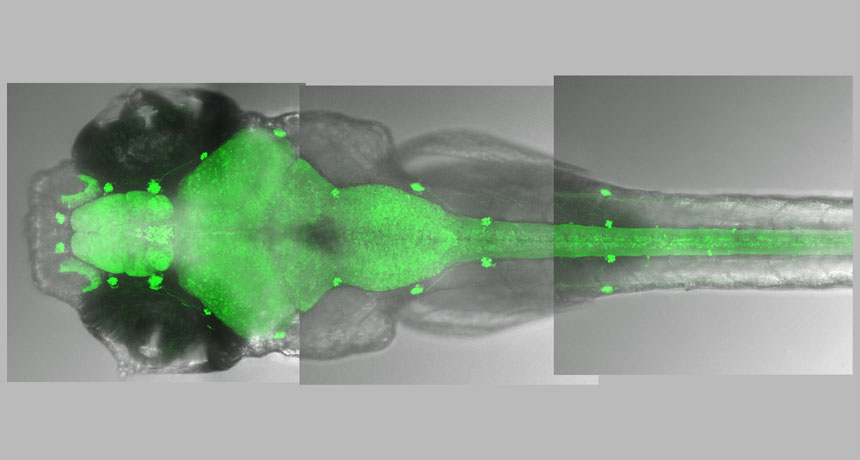Both fish and humans have REM-like sleep
Sleep may have originated underwater 450 million years ago

NIGHT LIGHT For the first time, scientists have monitored fish brain activity during sleep by using a zebrafish engineered to make a fluorescent molecule that lights up when nerves (green) or muscles become active.
L.C. Leung
- More than 2 years ago
No one should have to sleep with the fishes, but new research on zebrafish suggests that we sleep like them.
Sleeping zebrafish have brain activity similar to both deep slow-wave sleep and rapid eye movement, or REM, sleep that’s found in mammals, researchers report July 10 in Nature. And the team may have tracked down the cells that kick off REM sleep.
The findings suggest that the basics of sleep evolved at least 450 million years ago in zebrafish ancestors, before the evolution of animals that give birth to live young instead of laying eggs. That’s 150 million years earlier than scientists thought when they discovered that lizards sleep like mammals and birds (SN: 5/28/16, p. 9).
What’s more, sleep may have evolved underwater, says Louis C. Leung, a neuroscientist at Stanford University School of Medicine. “These signatures [of sleep] really have important functions — even though we may not know what they are — that have survived hundreds of millions of years of evolution.”
In mammals, birds and lizards, sleep has several stages characterized by specific electrical signals. During slow-wave sleep, the brain is mostly quiet except for synchronized waves of electrical activity. The heart rate decreases and muscles relax. During REM or paradoxical sleep, the brain lights up with activity almost like it’s awake. But the muscles are paralyzed (except for rapid twitching of the eyes) and the heart beats erratically.
For many years, scientists have known that fruit flies, nematodes, fish, octopuses and other creatures have rest periods reminiscent of sleep. But until now, no one could measure the electrical activity of those animals’ brains to see if that rest is the same as mammals’ snoozing.
Leung and colleagues developed a system to do just that in zebrafish by genetically engineering them to make a fluorescent molecule that lights up when it encounters calcium, which is released when nerve cells and muscles are active. By following the flashes of light using a light sheet microscope, the researchers tracked brain and muscle activity in the naturally transparent fish larvae.
The next task was to lull fish asleep under the microscope. In some experiments, the team added drugs that trigger either slow-wave or REM sleep in mammals to the fish’s water. In others, researchers deprived fish of sleep for a night or tuckered the fish out with lots of activity during the day. Results from all the snooze-inducing methods were the same.
Sleeping fish have two distinct types of brain activity while sleeping, the team found. One, similar to slow-wave sleep, was characterized by short bursts of activity in some nerve cells in the brain. The researchers call that state slow-bursting sleep. REM-like sleep, which the researchers dubbed “propagating-wave sleep,” was characterized by frenzied brain activity that spreads like a wave through the brain. The researchers aren’t calling the sleep phases REM or slow-wave sleep because there are some minor differences between the way fish and mammals sleep.
A group of cells that line hollow spaces called ventricles deep in the brain seems to trigger that wave of REM-like brain activity. These ependymal cells dip fingerlike cilia into the cerebral spinal fluid that bathes the ventricles and the central nervous system. The cells appear to beat their cilia faster as amounts of a well-known, sleep-promoting hormone called melanin-concentrating hormone in the fluid increases, the researchers discovered.
It’s unclear how the ependymal cells communicate with the rest of the brain to set off REM-like activity. Such cells are also present in mammals, but no one has yet been able to see that deeply into the brains of sleeping mammals to determine whether the cells play a role in sleep. But knowing about these cells may help researchers develop better sleep aids, Leung says.
Just as in mammals, zebrafish’s whole bodies are affected during sleep. Their muscles relax during sleep and their hearts slow from about 200 beats per minute when awake to about 110 to 120 beats per minute while asleep during the slow-wave–like sleep. During the REM-like sleep, the heart slows even more to about 90 beats per minute and loses its regular rhythm. And the fish’s muscles also go completely slack. The one characteristic that the fish lack is rapid eye movement. Instead, the eyes roll back into their sockets, says study coauthor Philippe Mourrain, a biologist at Stanford University School of Medicine.
Lack of eye movement could indicate that emotion-processing parts of the brain, such as the amygdala, aren’t as active in zebrafish as they are in mammals, says sleep researcher Allan Pack of the University of Pennsylvania Perelman School of Medicine. With their brain-activity monitoring, the researchers have taken sleep research “to the next level,” says Pack, and “they present pretty compelling evidence” of slow-wave and REM-like sleep in the fish.
The whole-body involvement that the researchers documented solidifies the argument that fish sleep is similar to mammals, says neuroscientist Paul Shaw of Washington University School of Medicine in St. Louis. In all organisms known to snooze, “sleep is manifest everywhere” in the body, he says.
Future experiments may show why poor sleep or a lack of Zs contributes to health problems in people, such as obesity, heart disease and diabetes.






